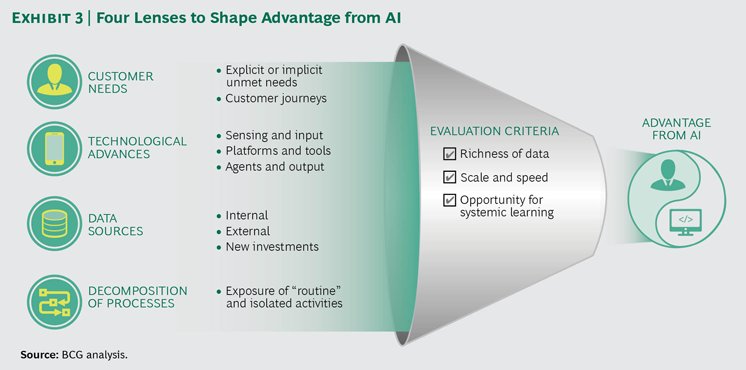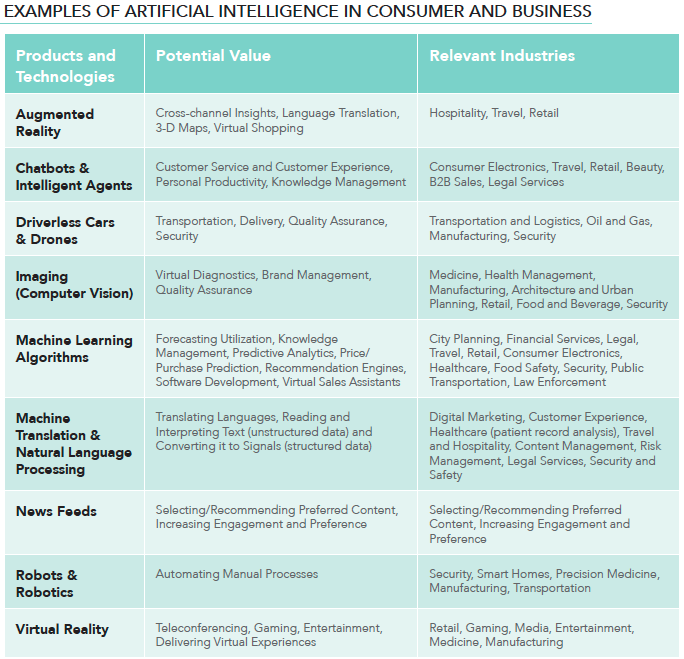
Whoever reads a science fiction novel ends up thinking about smart machines that can sense, learn, communicate and interact with human beings. The idea of Artificial Intelligence is not new, but there is a reason if big players like Google, Microsoft or Amazon are betting precisely on this technology right now.
After decades of broken promises, the AI is finally reaching its full potential. It has the power to disrupt your entire business. The question is: How can you harness this technology to shape the future of your organization?
Ever since the human has learned to dream, he has dreamed about ‘automata’, objects able to carry out complex actions automatically. The mythologies of many cultures - Ancient China and Greece, for example - are full of examples of mechanical servants.
Engineers and inventors in different ages attempted to build self-operating machines, resembling animals and humans. Then, in 1920, the Czech writer Karel Čapek used for the first time the term ‘Robot’ to indicate artificial automata.
The rest is history, with the continuing effort to take the final step from mechanical robots to intelligent machines. And here we are, talking about a market expected to reach over five billion dollars by 2020 (Markets & Markets).
The stream of news about the driverless cars, the Internet of Things, and the conversational agents is a clear evidence of the growing interest. Behind the obvious, though, we can find more profitable developments and implications for the Artificial Intelligence.
Back in 2015, while reporting our annual trip at the SXSW, we said that the future of the customer experience goes inevitably through the interconnection of smart objects.
The AI is a top choice when talking about the technologies that will revolutionize the retail store and the physical experience we have with places, products, and people.
The hyperconnected world we live in has a beating heart of chips, wires, and bytes. This is not a science fiction scenario anymore; this is what is happening, here and now, even when you do not see it.
The future of products and services appears more and more linked to the development of intelligent functions and features. Take a look at what has been done already with the embedded AI, that can enable your product to:
- Communicate with the mobile connected ecosystem - Just think about what we can already do using Google Assistant on the smartphone, or the Amazon Alexa device.
- Interact with other smart objects that surround us - The Internet of Things has completely changed the way we experience the retail store (and our home, with the domotics).
- Assist the customer, handling a wider range of requests - The conversational interfaces, like Siri and the chatbots, act as a personal tutor embedded in the device.
As the years pass by, the gap between weak and strong AI widens increasingly. A theory revived by a recent report by Altimeter, not by chance titled “The Age of AI - How Artificial Intelligence Is Transforming Organizations”.
The difference can be defined in terms of the ability to take advantage of the data to learn and improve. Big data and machine learning, in fact, are the two prerequisites of the modern smart technology.
So, on the one hand, we have smart objects that can replace the humans on a specific use case - i.e. to free us from heavy and exhausting duties - but do not learn or evolve in time.
On the other hand, we have the strong AI, the most promising outlook: An intelligence so broad and strong that is able to replicate the general intelligence of human beings. It can mimic the way we think, act and communicate.
The “pure AI” is aspirational but - apart from the Blade Runner charm - this is the field where all the tech giants are willing to bet heavily. The development and implementation of intelligent machines will define the competitive advantage in the age of AI.
According to BCG, “structural flexibility and agility - for both man and machine - become imperative to address the rate and degree of change.” As you can see in the following graph, you should look at the AI through four lenses:
- Customer needs
- Technological advances
- Data sources
- Decomposition of processes

First things first. It is important to incorporate the technological advances, gather the different data sources, and map the different processes involved. However, it is way more important to start from the basics, the customers.
Many types of research tend to focus on the tech-side of the moon but there is something you should never forget: everything starts with the customer. This is the pillar of every organization, and it is not going to change because of smart machines.
“Know your customer” means that you must to understand their needs, desires, pain points, and behaviors. Your business potential lies in the acknowledgment of the centrality of people.
The AI is a tool, not the purpose. The ultimate purpose is to create the best customer experience, blending technology and emotions so that you can engage your customers, monetize the opportunities, and increase the relevance of your brand.
Everything is connected to the customer:
“The opportunity (and risk) of AI is not just in a device that will play a song or order tickets to a concert. The value of systems based on machine learning is based on their ability to sense, communicate, learn, act, and adapt over time and to connect with other systems that do the same so that they can anticipate and act on a range of needs - be they related to medicine commerce, service and support, or customer experience.” (Altimeter - The Age of AI)

Now that the boundaries between what is human and what is artificial blur, there is one last element that you should never forget. The relationship with your customers is grounded in trust.
Transparency (in the use of data, in the management of the real-time interactions) is essential to win the distrust when the distinctions between human, AI-assisted, and AI interactions could very well disappear.
As Pedro Domingos, the author of The Master Algorithm, once said that the “Artificial Intelligence is not so scary as it seems when it translates into artificial smartness.”
Download The Mobile Engagement Playbook, a collection of relevant insights based on many years of Neosperience's expertise that'll help you to overcome the challenges of the digital transformation and grow your business exponentially.



 Your magnifing glass to deeply understand your users and increase the value of each relatonship.
Your magnifing glass to deeply understand your users and increase the value of each relatonship. Listen to the voice of your customers deeply to understand what they truly want.
Listen to the voice of your customers deeply to understand what they truly want. The Lead Generation Platform to get leads from anonymous traffic on your website.
The Lead Generation Platform to get leads from anonymous traffic on your website.  Understand the behavior of people in physical spaces and monitor safety requirements.
Understand the behavior of people in physical spaces and monitor safety requirements. The Digital Commerce Platform designed to follow the most modern technological standards..
The Digital Commerce Platform designed to follow the most modern technological standards.. The XReality platform to tell brand and product stories by connecting physical and digital worlds.
The XReality platform to tell brand and product stories by connecting physical and digital worlds. Points, rewards, levels, badges, missions: a world of nudges to nurture your customer community.
Points, rewards, levels, badges, missions: a world of nudges to nurture your customer community. Discover all the other solutions!
Discover all the other solutions!









